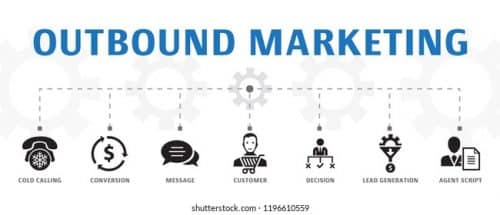Basically, most marketers, when asked how they acquire leads and fill the top of their sales funnel, say outbound marketing Strategy.
In 2023, however, many innovative and successful organizations are adopting the technique of inbound marketing. But what is the distinction between inbound and outbound traffic? This post will compare outbound marketing vs inbound marketing with some examples and see some effective tools for this marketing.
First, we’ll generally discuss more traditional outbound marketing strategies.
What is Outbound Marketing?
Outbound marketing is a typical marketing approach that seeks to push communications to potential buyers. Trade exhibitions, seminar series, and also cold phoning are all part of an outbound marketing strategy. It is expensive, and the ROI is substantially lower than that of inbound marketing.
Trade exhibitions, seminar series, email blasts to purchased lists, internal cold calling, outsourced telemarketing, and also advertising are all examples of outbound marketing. These are examples of “outbound marketing,” because marketers spread their message far and wide in the hope that it will resonate with that needle in the haystack.
Outbound marketing strategies, in my opinion, are becoming less effective over time for two reasons. To begin, the average person nowadays has over 2000 outbound marketing interruptions each day. This is devising increasingly inventive ways to block them out, such as caller ID, spam filtering, Tivo, and Sirius satellite radio.
What exactly is the issue with Outbound Marketing?
Many organizations spend the majority of their marketing budgets on outbound marketing. It’s been around for a long time, and some people even consider it a cost of doing business. Outbound marketing, on the other hand, poses many challenges, and history and past blunders should never get in the way of adjusting to evolving marketing trends. Outbound marketing has the following drawbacks:
- Difficulty in tracking return on investment (ROI)
- Increasing blocking techniques (Do not call list, Spam filters, TiVo, etc)
- High expense, poor yield.
According to CRM Daily, “nearly half of the companies that implement inbound marketing efforts see a 25% greater return on investment (ROI) on those programs than companies that do not.” The survey also discovered that “inbound marketing channels can deliver up to 30 times the campaign conversion rate of traditional outbound direct-mail campaigns.” Your next step, of course, is to reduce costs while increasing conversions by shifting from outbound to inbound marketing. Let’s compare outbound marketing vs inbound marketing.
Outbound Marketing vs Inbound Marketing
Outbound marketing is when a marketer contacts people to see if they have an interest in a product. This could include door-to-door sales or cold calling, in which a sales representative or marketer approaches someone without knowing whether or not he or she is a qualified lead. Inbound marketing is a strategy in which you create content or use social media tactics to raise brand awareness so that people learn about you, visit your website for more information, and then buy or show interest in your product.
While some outbound marketing strategies require a significant amount of time and effort and may yield no leads, inbound strategies allow you to engage an audience of people who you can more easily qualify as a prospect or lead.
Outbound Marketing vs Inbound Marketing Illustration
The best analogy I can think about outbound marketing vs inbound is traditional marketers looking to attract new potential customers are like lions hunting elephants in the jungle. The elephants used to be in the jungle when they were learning their craft in the 1980s and 1990s, but they don’t seem to be there now. They’ve all flocked to the savannah’s watering holes (the internet). So, rather than continuing to seek in the jungle, I advocate establishing up shop near the watering hole or converting your website to become its own watering hole.
Outbound marketing is the inverse of inbound marketing, in which clients find you when they need you. Content marketing, blogging, SEO, and opt-in email marketing are examples of inbound marketing. Furthermore, paid search advertising is called inbound marketing because your adverts only display when consumers search for products or services that you provide.
Outbound marketing is generally more difficult to track and less profitable than inbound marketing, but organizations continue to spend up to 90% of their marketing budgets on outbound marketing.
Organizations that want to increase their sales and return on marketing expenditure should re-allocate a growing portion of their marketing budget to inbound marketing tactics.
Outbound Marketing Examples
Here are some outbound marketing examples
#1. PPC (pay-per-click) marketing
By paying to advertise on search engines such as Google, Yahoo! Your message will be viewed by leads searching for terms related to your business on Google, Yahoo, and Bing. Pay-per-click (PPC) ads appear on the side and top of organic search results and employ tailored ad language to entice leads to click a high-value offer, such as a content piece that directly connects to a search keyword.
Content syndication can consist of both sponsored efforts, such as selecting websites to host your content, and nonpaid efforts, such as posting a guest blog post on an industry association’s website or spreading your content via RSS feeds and social media.
#3. Direct mail
Although there are numerous opinions on the effectiveness of direct mail, when you pair it with the other efforts, direct mail may be a highly effective approach to contact and engage your target audience.
#4. Marketing for events
Event marketing is an excellent approach to generate leads, build long-term relationships, and also engage with current customers for upselling and cross-selling opportunities. Events, which typically take the form of webinars, conferences, tradeshows, or seminars, provide your firm with the opportunity to meet your leads face-to-face and leave a lasting impression.
Common tools for event marketing include brochures, flyers, posters, pop-up stands, and similar promotional items. You can try Adobe’s free brochure maker for a quick way to design your own.
#5. Inside sales
The capacity to convert marketing leads into a sales pipeline is critical to the success of your lead generation operations. Your inside sales staff can assist you with this. Inside sales take marketing-generated leads, calls, and qualify them, and then pass them on to an account executive or a more experienced salesperson to close.
#6. Email marketing
Email marketing frequently makes use of leads existing in your database or leads from a list. You can generate additional buzz and demand for your company by creating emails to promote content pieces, events, new product launches, and so on.
Outbound Marketing’s Top 10 Tools
Generally, proper research is required to present you with several such outbound marketing tools that can provide you with the best results. Moreover, this is a list of some examples of such tools that are known to be highly efficient for outbound marketing.
If you’re looking for a social selling tool, this could be the one. It assists in a variety of ways, including focusing on the right prospects, staying informed through insights, and also developing trustworthy relationships.
Sales Navigator provides you with a variety of advantages, including:
- Receiving customized lead recommendations based on your preferences can be extremely beneficial in terms of generating leads and conversions.
- The advanced search feature assists in locating the right leads, which will ultimately increase your sales.
- Salesforce data can be imported with a single click, allowing you to run a more result-oriented campaign.
- Full profiles from your networks can also be accessed, and real-time sales updates for both customers and prospects can be obtained.
- TeamLink will assist you in gaining access to your teammates’ networks, allowing for better channelization of processes critical to achieving business objectives.
- You can send about 30 InMail messages per month to make better contacts that can later be converted into sales.
#2. HubSpot CRM Tool
Hubspot’s tool is great for quickly adding contacts with the click of a button. It assists in the creation of manageable templates, documents, and also messages that can be easily shared with prospects.
It also aids in the alignment of everything through emails, phone calls, the website, and social media. Because of its ability to influence the audience base in an automated as well as personalized manner, it has earned a spot on the list of best Outbound Marketing tools.
#3. InsideSales.com
This tool’s key features include gamification, communication, data visualization, and also predictive analytics. Some of the key advantages that the tool provides include contacting prospects at the right place and right time, motivating the sales team, predicting the leads that can be contacted, and thus making the data actionable.
So, this one will generate more relevant leads for you by utilizing some outbound marketing strategies, allowing this tool to secure a place among the best outbound marketing tools.
The tool will assist you in the following ways:
- Prioritize and Target
- Connect and Engage
- Qualify and Convert
#4. The Sales Loft
Generally, the program Sales Loft is primarily used to increase appointments and qualified demos by approximately 300 percent. Cadence and Prospector are two products that can be used with the software.
- Cadence
It allows you to design your own process for things like sales development phone calls, emails, and so on.
- The prospector
Generally, this leverages the power of social networks to automate link building, and contacts can be synced directly to the CRM.
#5. Sales Promotion
This tool leverages the power of Big Data to perform a variety of duties such as feeding pipelines, analyzing companies, and eventually providing smart lead insights. The best practices, such as the usage of sales intelligence and contacting deeper levels, yield the richest insights.
It has the following crucial features:
- Conceptual Search assists you in capturing, comprehending, and also connecting businesses with relevant themes.
- Business signals will provide richer and also more intelligent insights.
- Ideal Profile makes use of both conceptual search and commercial signals.
- Smart lists can help you generate the right leads.
#6. Carburetor
This is a tool primarily utilized for predictable revenue and efficiently manages the email stream.
This is also how it works in practice:
- Executive-level meetings are strengthened by the addition of new clients who are extremely useful.
- This is accomplished by building profiles and then searching for appropriate matches for the profile.
- The Carburetor sales team is reviewing the matches, and a meeting is planned for the near future.
Because of such essential feature sets, this one is included in the list of finest outbound marketing tools.
#7. The Wise Parrot
This tool is particularly useful in providing a variety of services such as personnel acquisition management, marketing, sales enablement, customer service, and even personal messaging for productivity.
The tool’s features can be summarized as follows:
- Real-time access to pertinent queries,
- Simplifying the follow-up process with targeted communication,
- Rapid response from prospects,
- Individualized outreach,
- The sales cycle is being shortened.
#8. InsideView Sales
This aids in interacting and closing negotiations with prospects, as well as providing the most accurate insights. InsideView for Sales can, in a nutshell, do the following:
- Analyze sources in real-time and also provide data about your customers that can be extremely beneficial in making your campaign highly result-driven.
- Appropriate data is obtained that will assist you in engaging with timely insights via a warm introduction, which will be the primary driver behind the significant boost in conversions for your organization.
- Target lists can be constructed based on custom criteria, which will be very beneficial in executing campaigns that produce the desired results.
- Data is directly synchronized to the CRM to automate the personalized channelization of your outbound marketing campaign.
#9. Close.io
Basically, if you do not want to do any manual labor, this is the one you should get. It keeps track of your emails and allows you to make phone calls with a single click.
Furthermore, the dashboard provides you with a quick overview of all the deals in your pipeline. It organizes the leads by week, tracks the estimated value, and provides assurance that the sale will be closed on time.
The tool’s lead page provides a variety of facts such as tasks, lead information, contacts, opportunities, and many more.
Close.io provides the following products:
- A Quick Overview
- Sending an email
- Making a report
- SMS (Short Message Service)
- Integrations and APIs
- Automated Dialing
- Dialer Predictive
- Smart Views and Search
Such incredible feature sets enable Close.io to be one of the top Outbound Marketing tools, allowing organizations to improve their reach, targeting, lead generation, and conversions.
#10. Outreach
Among the different outbound marketing tools, this is the only one that understands follow-ups and so helps you achieve big sales goals. The tool assists you in:
- Using an email address to generate more qualified leads
- Using email and phone to optimize your outbound marketing strategies
- Connecting between Salesforce and Gmail to automate marketing processes
- Emails are automatically followed up on to ensure greater engagement and conversions.
- Scheduling emails to channel well-planned email campaigns
- Detecting email responses in an automated method for better results
- Putting the next stages in order and keeping track of the prospects in the funnel,
- Keeping track of the various tasks in the queue and running A/B tests expertly
- Managing the team’s reporting in a well-optimized and automated manner
How can Outbound Marketing be measured and evaluated for effectiveness?
Outbound Marketing can be measured through a variety of metrics, including response rates, conversion rates, and ROI. For example, response rates can indicate the number of people who responded to your campaign, conversion rates can indicate the number of people who took the desired action, and ROI can indicate the amount of money returned for each dollar spent on the campaign.
What is the future of Outbound Marketing and where is it headed?
The future of Outbound Marketing is likely to see a shift towards more personalized, data-driven strategies, as well as a continued focus on creating engaging and relevant content that resonates with target audiences. Some experts also predict that Outbound Marketing will continue to evolve to meet the changing needs and preferences of consumers, as well as advances in technology.
How can a business ensure the success of its Outbound Marketing efforts?
To ensure the success of Outbound Marketing efforts, a business should start by identifying their target audience and defining clear goals and objectives. From there, they should develop a comprehensive strategy that includes a mix of tactics, such as email marketing, direct mail, and advertising, and utilize data and analytics to continually optimize their efforts. Additionally, it is important to have a clear plan for measuring and evaluating the success of your Outbound Marketing efforts, so that you can make data-driven decisions about what is working and what is not.
What are the common challenges faced in Outbound Marketing and how can they be overcome?
Some of the common challenges faced in Outbound Marketing include reaching a highly targeted audience, effectively measuring the success of your efforts, and avoiding the risk of being seen as spammy or intrusive. To overcome these challenges, it is important to carefully segment your target audience, utilize advanced analytics and data to understand their behavior and preferences, and utilize a mix of tactics to reach them in meaningful ways. Additionally, it is important to be transparent about the purpose of your Outbound Marketing efforts, and to give customers the ability to opt-out if they choose to do so.
What are the latest trends and innovations in Outbound Marketing?
Some of the latest trends and innovations in Outbound Marketing include the use of AI and machine learning to automate and personalize Outbound Marketing efforts, the integration of augmented reality and virtual reality technologies, and the use of social media influencer marketing to reach target audiences. Additionally, there is a growing trend towards Outbound Marketing strategies that prioritize customer experience and engagement, as well as those that are more data-driven and focused on driving real business outcomes.
What is the role of Outbound Marketing in a customer’s journey?
The role of Outbound Marketing in a customer’s journey is to help attract and engage potential customers, build brand awareness and preference, and ultimately drive conversions and sales. By utilizing a variety of tactics and channels, Outbound Marketing can help businesses reach and engage customers at different stages of the buying journey, from initial awareness and consideration, to making a purchase and becoming a loyal customer. Additionally, Outbound Marketing can help businesses foster relationships with customers over time, and build a loyal following of brand advocates who will help spread the word about your business to others.
Conclusion
We have all that outbound marketing entails with some examples and also compared outbound vs inbound marketing. Although the outbound marketing strategy may be a traditional marketing method it’s still relevant for businesses, especially with the right marketing tools.
Moreover, using the proper outbound marketing tool will allow you to run more successful and result-driven programs that deliver the anticipated outcomes in the shortest amount of time.
Which tool piqued your interest the most? Or did we overlook any Outbound Marketing tools that you prefer? You can leave your thoughts in the comments area.
Outbound Marketing FAQs
What are outbound marketing strategieds?
Outbound marketing is any kind of marketing where a company makes the initial first contact with its audience and potential customers. Examples of outbound marketing activities include TV ads, radio ads, trade shows, print media, cold calling, cold emails, and so on.
What are examples of outbound marketing?
Examples of outbound marketing methods include cold-calling, cold-emailing/spamming, direct mail, billboards, event sponsorships, tradeshow presentations, advertising through TV, radio, print, and online or through in-person contact.
Is Google ads inbound or outbound?
If you were in a room full of inbound marketers a couple of years ago, advertising on Google wasn’t a strategy you heard too much about
Is email marketing inbound or outbound?
The ideal ratio of inbound and outbound will depend on the nature of your business and customer base. However, the general principle that email marketing should be primarily inbound and complemented by more traditional outbound efforts applies universally.
- Types of Marketing Strategies: 20+ that Works for any Business
- Lead Generation: Definition, Process, Tools, and Strategies (Simplified )
- Free Example of a Business Plan
- Best Email Marketing Campaign Examples (+ Detailed Guide)
- INTERNAL MARKETING STRATEGIES: How to Create an Effective Marketing Brand






